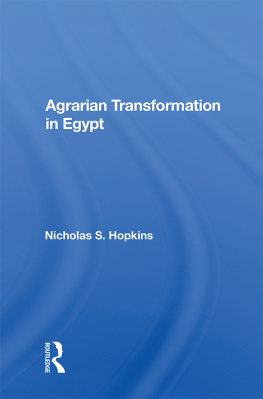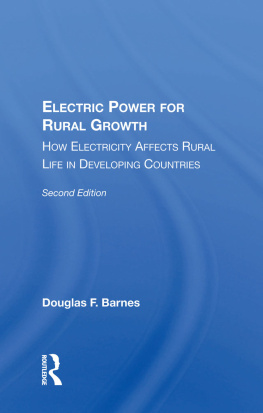DIRECTIONS OF CHANGE
IN RURAL EGYPT
DIRECTIONS OF
CHANGE IN
RURAL EGYPT
Edited by
NICHOLAS S. HOPKINS
KIRSTEN WESTERGAARD
The American University in Cairo Press
Copyright 1998 by
The American University in Cairo Press
113 Shana Kasr el Aini, Cairo 11511, Egypt
420 Fifth Avenue, New York, NY 10018-2729
http://www.aucpress.com
This edition in paperback 2001
All rights reserved. No part of this publication
may be reproduced, stored in a retrieval system or
transmitted in any form or by any means,
electronic, mechanical, photocopying, recording,
or otherwise, without the prior written permission
of the publisher.
Dar el Kutub No. 4677/01
ISBN 978 161 797 253 9
Printed in Egypt
Contents
Introduction: Directions of Change in Rural Egypt
Nicholas Hopkins and Kirsten Westergaard
1. The Markets Place
Timothy Mitchell
2. The Evolution of Agrarian Structures in Egypt: Regional Patterns of Change in Farm Size
Francois Ireton
3. Beating Plowshares into Swords: The Relocation of Rural Egyptian Workers and their Discontent
James Toth
4. Facing Structural Adjustment: Strategies of Peasants, the State, and the International Financial Institutions
Ray Bush
5. Hegemony in the Periphery: Community and Exclusion in an Upper Egyptian Village
Reem Saad
6. The Northwest Coast: A Part of Rural Egypt?
Soraya Altorki and Donald P. Cole
7. Television and the Virtues of Education: Upper Egyptian Encounters with State Culture
Lila Abu-Lughod
8. Conflict or Cooperation: Changing Gender Roles in Rural Egyptian Households
Kamran Asdar Ali
9. The Vision of a Better Life: New Patterns of Consumption and Changed Social Relations
Kirsten Haugaard Bach
10. Being Sickly or Eating Well: The Conceptualization of Health and Ill-Health in an Upper Egyptian Village
Hania Sholkamy
11. Health Units in Rural Egypt: At the Forefront of Health Improvement or Anachronisms?
Sohair Mehanna and Peter Winch
12. Change and Continuity in the Village of Batra: Family Strategies
Malak S. Rouchdy
13. Spaces of Poverty: The Geography of Social Change in Rural Egypt
Detlef Mller-Mahn
VI DEVELOPMENT: THE ROLE OF THE MARKET AND
DEVELOPMENT PROJECTS
14. Farmers and Cooperatives in the Era of Structural Adjustment
Mohamed H. Abdel Aal
15. Rural Periodic Markets in Egypt
Mohamed M. Mohieddin
16. Agro-Pastoralism and Development in Egypts Northwest Coast
Donald P. Cole and Soraya Altorki
17. Economic Changes in the Newly Reclaimed Lands: From State Farms to Small Holdings and Private Agricultural Enterprises
Gnter Meyer
18. Men of AuthorityDocuments of Authority: Notes on Customary Law in Upper Egypt
Hans-Christian Korsholm Nielsen
19. Culture and Mediation of Power in an Egyptian Village
Ahmed Zayed
In April 1997, a group of specialists on rural Egypt gathered in Aswan to consider the state of culture, society, and economy in contemporary Egypt. The group included anthropologists, sociologists, political scientists, and geographers, and participants were from Egypt and a variety of other countries. All had done recent field research in rural Egypt. The research sites ranged from Marsa Matruh in the Western Desert to Sharqiya governorate in the eastern Delta, and on to the reclaimed areas near Ismailiya, and from Batra in the northern Delta, to Idfu in the southern governorate of Aswan.
The conference was a result of a research project covering the social organization of work and production in the two Upper Egyptian governorates of Qina and Aswan, conducted by the Social Research Center (SRC) of the American University in Cairo and funded by the Danish International Development Agency (DANIDA) in Cairo. The research project is part of a broader collaboration between the SRC and the Centre for Development Research (CDR) in Copenhagen, Denmark, funded by DANIDA through its ENRECA program, which also funded the conference. This book incorporates some of the results of the collaboration (papers by Abdel Aal, Bach, Nielsen, and Saad) along with work by many scholars who were not affiliated to the SRC/CDR research project. The editing of the book was also undertaken under the ENRECA program.
This book is the outcome of that gathering of lively, young scholars. It includes information on the changing economic situation in the countryside, particularly after the owners and tenants law of 1992, which has now come into force, along with the effects of structural adjustment on agriculture, marketing, and rural life. A number of papers cover the changing and probably declining role of migration abroad in the strategies of rural Egyptians. Another set of papers treats the changes in consumption patterns, in house style, in dress fashion, and in the role of television. One of the basic measures of well-being is health, and that is covered directly in two papers. Other papers deal with social processes in rural areas, including dispute settlement and the response to development programs. Still further papers deal with the expansion of agriculture outside the traditional areas of the Nile Valley, and the increasing integration of the ecologically distinctive areas of the northwest coast of Egypt into the agrarian economy of the Nile Valley. A final set of papers deals with representations of the rural population, the peasantry, or fallahin, in the media, in statistics, and among themselves.
Overall, the papers show a rural Egypt that is full of life, constantly changing, and always teetering on the edge between progress and impoverishment. Though nothing is typical of rural Egypt, these papers provide an up-to-date account of the stresses and strains, strivings and silences, progress and threat, that characterize the Egyptian countryside today. Geographically, the papers cover old lands, new lands, and the desert fringes. Topically, the range is from straightforward analyses of the social organization of production to cultural analyses of symbols and discourses. All of the papers focus on current directions of change and are sensitive in various ways to the influences that bear on Egyptian agriculture from the outside as well as the pressures internal to it.
The organizers and editors want to thank first of all the two host institutions, the Social Research Center of the American University in Cairo, and the Centre for Development Research in Copenhagen. Several figures in these two institutions were instrumental in encouraging this project in its early stages and throughout. We would like to extend particular thanks to Saad Nagi, the former director of the SRC, and Knud Erik Svendsen, the former director of the CDR. The current director of the SRC, Hoda Rashad, also gave her wholehearted support to the project, and joined in the Aswan discussions. This project would not have come into being without the support of the DANIDA office in Cairo, and in particular Ole Moesby, and later Kurt Mrck Jensen, Lis Jespersen, and Ali Kerdany. Throughout all the various phases of this project we benefited from our cooperation with the Governor of Aswan, His Excellency Salah Mosbah, who participated in both the opening and closing sessions of the conference.






